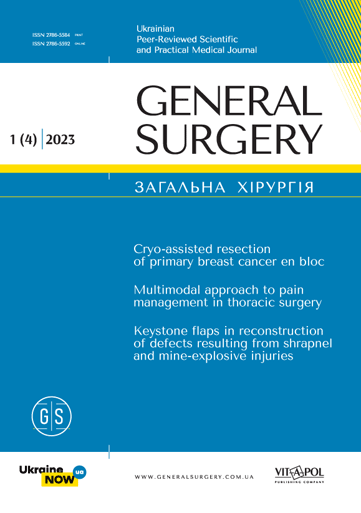Keystone perforator island flaps in the reconstruction of lower limb defects resulting from shrapnel and mine-explosive combat injuries. Case series
DOI:
https://doi.org/10.30978/GS-2023-1-48Keywords:
reconstructive surgery, perforator flap, combat injury, wounds, keystone flapAbstract
In the conditions of warfare in Ukraine, the question of providing medical services to injured civilian and military is especially relevant and severe. In plastic surgeons` professional activities, the task is to restore extensive and deep wound defects in a short term and with a high degree of damaged organ`s restoration, especially supporting function. In this article the authors describe their experience with local keystone perforator island flaps, which are used to reconstruct skin and soft tissue defects of the lower limbs caused by combat injuries.
Patients and methods. The authors conducted a retrospective review of 49 keystone perforator flaps for 28 patients (26 men and 2 women) who received treatment in the clinic for bullet, shrapnel, and mine‑explosive injuries between 2014 and 2022.
Results. In all cases, extensive wound defects were completely closed during a single‑stage surgical procedure, and the patients were discharged after recovery. Non‑critical complications required secondary sutures in two cases (4%), extending the duration of treatment by 6 days. The time spent in the operating room on the transposition of one flap ranged from 40 to 95 min (mean: 67 min).
Conclusions. The findings of the study show that local keystone perforator island flaps are highly effective in the successful reconstruction of lower limb defects caused by combat wounds. The keystone perforator island flap technique requires basic preoperative preparation of the patient, is easy‑to‑use, and exhibits a fairly high level of reliability at the same time. In most cases, keystone perforator island flaps provide primary and single‑stage closure of a large defect in the thigh, in the area of the knee joint, and in the lower leg in the absence of secondary defects that are common at donor sites when alternative techniques are chosen.
References
AlMugaren FM, Pak CJ, Suh HP, Hong JP. Best local flaps for lower extremity reconstruction. Plast Reconstr Surg. Glob Open. 2020;8(4):e2774. http://doi.org/10.1097/GOX.0000000000002774. PMID: 32440438; PMCID: PMC7209892.
Badiul P, Sliesarenko S, Sliesarenko K. The local perforator flaps for plastic closure of extensive military wounds. Chirurgia Plastyczna i Oparzenia. 2015;2(3):59-60.
Behan F, Findlay M, Lo C. The keystone perforator island flap concept. Elsever, Australia; 2012. 227 p.
Behan F, Sizeland A, Porcedu S, Somia N, Wilson J. Keystone island flap: an alternative reconstructive option to free flaps in irradiated tissue. ANZ J Surg. 2006 May;76(5):407-13. http://doi.org/10.1111/j.1445-2197.2006.03708.x. PMID: 16768705.
Behan F, Wilson I. The principle of the angiotome, a system of linked axial pattern flaps. Paper presented at the Sixth International Congress of Plastic and Reconstructive Surgery. Paris; 1975.
Behan FC, Lo CH, Sizeland A, Pham T, Findlay M. Keystone island flap reconstruction of parotid defects. Plast Reconstr Surg. 2012 Jul;130(1):36e-41e. http://doi.org/10.1097/PRS.0b013e3182547f55. PMID: 22743953.
Behan FC, Lo CH, Sizeland A, Pham T, Findlay M. Keystone island flap reconstruction of parotid defects. Plast Reconstr Surg. 2012 Jul;130(1):36e-41e. http://doi.org/10.1097/PRS.0b013e3182547f55. PMID: 22743953.
Geiger S, McCormick F, Chou R, Wandel AG. War wounds: lessons learned from Operation Iraqi Freedom. Plast Reconstr Surg. 2008 Jul;122(1):146-153. http://doi.org/10.1097/PRS.0b013e3181773d19. PMID: 18594399.
Joon Pio Hong. The use of supermicrosurgery in lower extremity reconstruction: the next step in evolution. Plast. Reconsr Surg. 2009;123(1):230-5.
Kashtalyan MA, Нerasymenko OS, Tertyshniy SV, Enin RV. New trends in the treatment of gunshot wounds. Kharkiv Surgical School. 2017;1 (82):112-5.
Khouri JS, Egeland BM, Daily SD, Harake MS, Kwon S, Neligan PC, Kuzon WM Jr. The keystone island flap: use in large defects of the trunk and extremities in soft-tissue reconstruction. Plast Reconstr Surg. 2011 Mar;127(3):1212-1221. http://doi.org/10.1097/PRS.0b013e318205f36f. PMID: 21364423.
Kumar AR, Grewal NS, Chung TL, Bradley JP. Lessons from operation Iraqi freedom: successful subacute reconstruction of complex lower extremity battle injuries. Plast Reconstr Surg. 2009 Jan;123(1):218-229. http://doi.org/10.1097/PRS.0b013e3181904da9. PMID: 19116556.
Levine JP Pu, Lee LQ, Wei Fu-Chan, editors. Reconstructive surgery of the lower extremity. Quality Medical Publishing, Incorporated; 2013. 1368 p.
Sliesarenko SV, Badiul PA, Nor NN, et al. Avoiding skin grafts: the local perforator flap in cutaneous defects covering. Eur J Burn Care, 2019;160:P099.
Sliesarenko SV, Badiul PO, Sliesarenko KS. Extensive mine-shrapnel and gunshot wound closure using keystone island perforator flaps. Plast Reconstr Surg Glob Open. 2016 May 26;4(5):e723. http://doi.org/10.1097/GOX.0000000000000736. PMID: 27579247; PMCID: PMC4995696.
Sliesarenko SV, Badiul PO. Perforator flaps in reconstructive surgery. Atlas. Dnipro: ART-Press; 2021. 552 p.
Sliesarenko SV, Badyul PA, Cherednichenko NA, Fedorinchik MV. Combined use of local perforator transposition flaps in foot reconstruction. Klinicheskaia khirurgiia. 2012;11:31.
Stark HL. Directional variations in the extensibility of human skin. Br J Plast Surg. 1977 Apr;30(2):105-14. http://doi.org/10.1016/0007-1226 (77)90001-7. PMID: 870119.
Tsymbalyuk VI, ed. Gunshot wounds of soft tissues (Experience of an anti-terrorist operation/Operations of the united forces). Kharkiv: Kolegium; 2020. 400 p.
Downloads
Published
How to Cite
Issue
Section
License
Copyright (c) 2023 Authors

This work is licensed under a Creative Commons Attribution-NoDerivatives 4.0 International License.






